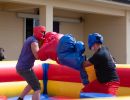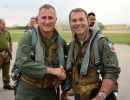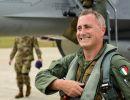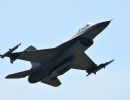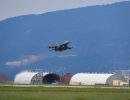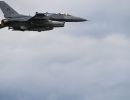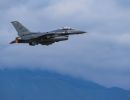Schlemming with the Fulcrum
Hehs, Eric. Code One: Jul 1995. Vol. 10 No. 3: Pg 10-19.
 Four Cyrillic letters adorn a toggle switch in the MiG-29 cockpit. The letters spell a word that sounds like schlemm. The switch activates a helmet-mounted sight system used to designate targets for one of the most formidable air-to-air missiles any USAF fighter pilot may ever face, and actually ever face-the AA-11 Archer. The system allows pilots of the MiG-29 to shoot the thrust-vectored Archer where their planes are not pointing. With a turn of the head, they can target opposing aircraft up to forty-five degrees off the nose of the MiG. When MiG-29 pilots of Germany's Jagdgeschwader 73 (Fighter Wing 73) use the helmet-mounted sight system in simulated engagements, they call it a schlemm shot. (Not surprising, schlemm means grand slam in German.)
Four Cyrillic letters adorn a toggle switch in the MiG-29 cockpit. The letters spell a word that sounds like schlemm. The switch activates a helmet-mounted sight system used to designate targets for one of the most formidable air-to-air missiles any USAF fighter pilot may ever face, and actually ever face-the AA-11 Archer. The system allows pilots of the MiG-29 to shoot the thrust-vectored Archer where their planes are not pointing. With a turn of the head, they can target opposing aircraft up to forty-five degrees off the nose of the MiG. When MiG-29 pilots of Germany's Jagdgeschwader 73 (Fighter Wing 73) use the helmet-mounted sight system in simulated engagements, they call it a schlemm shot. (Not surprising, schlemm means grand slam in German.)
Only a handful of US Air Force fighter pilots have ever been schlemmed. Those who have, though, consider themselves lucky. They have experienced what others have only read about or encountered in simulations. With experience comes credibility. And as of last May, the most credible squadron with it comes to fighting the MiG-29 is the 510th Fighter Squadron from Aviano Air Base in northern Italy.
 Most people associate Aviano with Deny Flight Operations over Bosnia. Many pilots of the 510th Squadron and its sister F-16 squadron, the 555th, have been flying over Bosnia from Aviano for almost three years without much attention. Until recently, that is. These days, the squadrons fly these missions for two-month shifts every six months. The units spend two of the remaining four months training at Aviano and two months deployed. On one. such deployment last year to Decimomannu Air Base on the southern tip of Sardinia, Capt. Will Sparrow of the 510th learned about an upcoming German MiG-29 visit to the island. The Fulcrums, he heard, were looking for aerial adversaries. 'We were on the phone about thirty seconds later getting our name on the books to come back down here," Sparrow said.
Most people associate Aviano with Deny Flight Operations over Bosnia. Many pilots of the 510th Squadron and its sister F-16 squadron, the 555th, have been flying over Bosnia from Aviano for almost three years without much attention. Until recently, that is. These days, the squadrons fly these missions for two-month shifts every six months. The units spend two of the remaining four months training at Aviano and two months deployed. On one. such deployment last year to Decimomannu Air Base on the southern tip of Sardinia, Capt. Will Sparrow of the 510th learned about an upcoming German MiG-29 visit to the island. The Fulcrums, he heard, were looking for aerial adversaries. 'We were on the phone about thirty seconds later getting our name on the books to come back down here," Sparrow said.
A few months after that call, the 510th headed back to Sardinia with ten F16s and an able support team for a four-week MiG-29 Fest. The JG-73 sent ten Fulcrums and fifteen air-to-air German F-4Fs. The pilots flew a variety of setups, from simple one F-16 flying basic fighter maneuvers against one MiG-29, to more complex encounters of four F-16s teamed against four MiG-29s. Two F-16s also flew against two MiG-29s and two F-4Fs. "We called that two v two-plus two," explained Sparrow. "The MiGs practice a lot of tactics with the F-4s to make use of the F-4's radar."
 The more complex engagements were simultaneously monitored by ground controllers who used the air combat maneuvering instrumentation facilities at Decimomannu to guide the aerial combatants. The ACMI facilities were also used by the aircrews to review the engagements. "Decimomannu is a fantastic place to train," said Sparrow, who was in charge of the deployment for the 510th. "The base has an ACMI that can't be beat for debriefing. And they have a bombing range nearby at Cappa Frasca."
The more complex engagements were simultaneously monitored by ground controllers who used the air combat maneuvering instrumentation facilities at Decimomannu to guide the aerial combatants. The ACMI facilities were also used by the aircrews to review the engagements. "Decimomannu is a fantastic place to train," said Sparrow, who was in charge of the deployment for the 510th. "The base has an ACMI that can't be beat for debriefing. And they have a bombing range nearby at Cappa Frasca."
"I hope this deployment receives a lot of attention because it deserves a lot," Sparrow continued. [Pictured on the left] "Not because we're here, but because we're learning about aircraft very similar to the German MiGs, aircraft that could cause us a lot of problems. As for what we expected before coming down here, we would get ten different answers from ten different pilots. We've heard a lot of things about the MiG-29. We all read the same stuff and get the same information. But we never really know what to believe. We now know they are a great adversary. They were everything I expected and more. Nothing can substitute for training like this. We go out and fight ourselves a lot and we try to make those encounters as realistic as possible. But this is the real thing. And these MiG pilots are really well trained.
 "Germany's MiG29 unit is based at Laage Air Base near Rostock on the Baltic coast. Before German reunification in 1990, the aircraft flew for the former East Germany and the Warsaw Pact. After reunification, the Fulcrums became a test wing for the German Air Force. In 1993, the unit became an operational wing. Its twenty-four Fulcrums and twenty-eight pilots officially became a combined wing with an F-4 unit from Pferdsfeld Air Base in 1994. The unit formally maintains an alert role and polices the air over the five republics that comprise the former East Germany. Many of Germany's MiG29 pilots are former F-4 pilots who were trained in the United States. These pilots volunteered to convert to the Fulcrum, which currently represents the most advanced fighter in the German Luftwaffe.
"Germany's MiG29 unit is based at Laage Air Base near Rostock on the Baltic coast. Before German reunification in 1990, the aircraft flew for the former East Germany and the Warsaw Pact. After reunification, the Fulcrums became a test wing for the German Air Force. In 1993, the unit became an operational wing. Its twenty-four Fulcrums and twenty-eight pilots officially became a combined wing with an F-4 unit from Pferdsfeld Air Base in 1994. The unit formally maintains an alert role and polices the air over the five republics that comprise the former East Germany. Many of Germany's MiG29 pilots are former F-4 pilots who were trained in the United States. These pilots volunteered to convert to the Fulcrum, which currently represents the most advanced fighter in the German Luftwaffe.
The JG73 has also retained a number of former East German MiG-29 pilots who have had to tailor their knowledge of the airplane to fit western style tactics. Most of the Fulcrum pilots have less than 300 hours in the aircraft. Only a few have over 400 hours. No one in the unit, including former East German pilots, has over 500 hours in the MiG29.
This was not the JG-73's first encounter with advanced western aircraft. The wing flew against Dutch F-16s at Decimomannu last year and against Spanish F18s for two weeks in 1993. The Germans deploy to Sardinia because the ACMI facilities are there and because air-to-air combat training is restricted over the former East Germany, which covers Laage Air Base. The restriction, however, may be dropped later this year.
"The highlight of this deployment for me has been the BFM [basic fighter maneuvering, i.e., modern dog fighting] against a clean F-16C," explained Capt. Oliver Prunk, the operations officer for the JG-73. "The F-16C performs significantly better in terms of power when compared with the F-16A. I was also pleased with the proficiency of the American pilots. They take their jobs very seriously. We try to be the best adversary we can. I think they were surprised with the performance of the MiG-29 and with what we can do with it."
The most impressive aspect of the Fulcrum's performance for the American pilots was its low-speed maneuverability. "In a low-speed fight, fighting the Fulcrum is similar to fighting an F-18 Hornet," explained Capt. Mike McCoy of the 510th. "But the Fulcrum has a thrust advantage over the Hornet. An F-18 can really crank its nose around if you get into a slow-speed fight, but it has to lose altitude to regain the energy, which allows us to get on top of them. The MiG has about the same nose authority at slow speeds, but it can regain energy much faster. Plus the MiG pilots have that fortyfive-degree cone in front of them into which they can fire an Archer and eat you up."
 The off-boresight missile, as described in the opening scenario, proved to be a formidable threat, though not an insurmountable one. "Some of their capabilities were more wicked than we originally thought," said McCoy. "We had to respect the helmet-mounted sight, which made our decisions to anchor more difficult. In other words, when I got close in, I had to consider that helmet mounted sight. Every time I got near a Fulcrum's nose, I was releasing flares to defeat an Archer coming off his rail."
The off-boresight missile, as described in the opening scenario, proved to be a formidable threat, though not an insurmountable one. "Some of their capabilities were more wicked than we originally thought," said McCoy. "We had to respect the helmet-mounted sight, which made our decisions to anchor more difficult. In other words, when I got close in, I had to consider that helmet mounted sight. Every time I got near a Fulcrum's nose, I was releasing flares to defeat an Archer coming off his rail."
"Before coming here, some of our pilots may have thought of the MiG's helmet-mounted sight as an end-all to a BFM fight," explained Lt. Col. Gary West, commander of the 510th. "We have found that it is not as lethal as we had expected. We encountered some positions-particularly in an across-the-circle shot or a high-low shot and in a slow-speed fight-where a Fulcrum pilot can look up forty-five degrees and take a shot while his nose is still off. That capability has changed some of the pilots' ideas on how they should approach a MiG29 in a neutral fight. Below 200 knots, the MiG-29 has incredible nose-pointing capability down to below 100 knots. The F-16, however, enjoys an advantage in the 200knot-plus regime. At higher speeds, we can power above them to go to the vertical. And our turn rate is significantly better. By being patient and by keeping airspeed up around 325 knots, an F-16 can bring the MiG29 to its nose. But the pilot must still be careful of the across-the-circle shot with that helmet-mounted display.
|
|
The MiG-29's avionics are a shortcoming. Its radar-warning and navigational equipment are not up to Western standards. Capt. Mike Raubback, a Fulcrum pilot of the JG-73 |
"We have done very well on neutral BFM engagements," continued West. "We have tried single- and two-circle fights, depending on how much lead turn we had at the merge. Without exception, we have been able to use finesse or power to an advantage after at least a couple of turns. I don't think any F-16 pilot has gotten defensive and stayed there. As always, and this applies to any airplane, success depends on who is flying."
Three pilots from the 510th received backseat rides in one of the JG-73's two-seat MiG-29 trainers. Capt. Sparrow was one of them. "The MiG is harder to fly than the F-16," said Sparrow. "The Soviet airframe is great, but the avionics are not user friendly. After flying in the backseat of the Fulcrum, I got a feel for how spoiled we are in the F-16. I always felt good about the F-16, but I wouldn't trade flying the F-16 for any other aircraft, foreign or domestic.
 "The Fulcrum doesn't have the crisp movements of an F-16," Sparrow continued. 'You need to be an octopus in the MiG29 to work the avionics. Those German pilots have it tough. Just to get a simple lock on and fire a missile may take a half dozen hands-off switches or so. We can do the same with a flick of the thumb while we are looking at the HUD. F-16 pilots also have a significant sight advantage. A couple of hundred feet advantage can make a difference in air-to-air combat; the actual difference is more significant than that. MiG29 pilots have a tough time checking their six o'clock. Their canopy rail is higher. They can lose sight of us even when flying BFM."
"The Fulcrum doesn't have the crisp movements of an F-16," Sparrow continued. 'You need to be an octopus in the MiG29 to work the avionics. Those German pilots have it tough. Just to get a simple lock on and fire a missile may take a half dozen hands-off switches or so. We can do the same with a flick of the thumb while we are looking at the HUD. F-16 pilots also have a significant sight advantage. A couple of hundred feet advantage can make a difference in air-to-air combat; the actual difference is more significant than that. MiG29 pilots have a tough time checking their six o'clock. Their canopy rail is higher. They can lose sight of us even when flying BFM."
"Their visibility is not that good," agreed McCoy, one of the other two pilots who enjoyed a spin in the Fulcrum. "Their disadvantage is a real advantage for us. F-16 pilots sit high in the cockpit. All the MiG29 pilots who sat in our cockpit wanted to look around with the canopy closed. They were impressed that they could turn around and look at the tail and even see the engine can."
"Besides visibility, I expected better turning performance," McCoy continued. "The MiG29 is not a continuous nine-g machine like the F-16. I tried to do some things I normally do in an F-16. For example, I tried a high-AOA guns jink. I got the Fulcrum down to about 180 knots and pulled ninety degrees of bank and pulling heavy g's I then went to idle and added a little rudder to get the jet to roll with ailerons. The pilot took control away from me in the middle of these maneuvers because the airplane was about to: snap. I use the F-16's quick roll rate like this all the time with no problem.
 "I also tried to do a 250-knot loop," McCoy recalled. "I went to mil power and stabilized. As I went nose high, I asked for afterburner. I had to hamfist the airplane a little as I approached the top of the loop. I was still in afterburner at about 15,000 feet and the jet lost control. The nose started slicing left and right. I let go of the stick and the airplane righted itself and went down. It couldn't finish the loop. In the F-16, we can complete an entire loop at 250 knots."
"I also tried to do a 250-knot loop," McCoy recalled. "I went to mil power and stabilized. As I went nose high, I asked for afterburner. I had to hamfist the airplane a little as I approached the top of the loop. I was still in afterburner at about 15,000 feet and the jet lost control. The nose started slicing left and right. I let go of the stick and the airplane righted itself and went down. It couldn't finish the loop. In the F-16, we can complete an entire loop at 250 knots."
Like Sparrow, McCoy climbed out of the MiG-29 cockpit feeling better about the F-16, especially its automation. "The biggest instrument in the MiG29 cockpit is the clock," McCoy said. "It took me a while to understand this. But a large clock is needed to keep track of the time after launching a missile. When they launch a missile, they have to consider their shot range and the type of missile they are shooting and estimate how long it will take to impact before firing. When they take a five-mile Alamo shot, for example, they have to calculate mentally the time required for the missile to reach its target so their radar can illuminate it for the duration. They fire and watch until they know when they can turn away. That procedure is a real disadvantage if they're flying against someone who shot a missile at them at about the same time.
"F-16 pilots don't have to think about these things," McCoy continued. "We have great automation. When we launch a missile, the airplane performs all the calculations and displays a countdown on the head-up display for us. When we're within ten miles, we want our eyes out of the cockpit looking for flashes or smoke from an adversary. That's why our head-up display is focused to infinity. We can view information without refocusing our eyes to scan the horizon. Inside of ten miles, Fulcrum pilots are moving their hands around flipping about six switches, some they have to look at. I am moving one, maybe two switches, without taking my hands off the throttle and stick."
|
Before coming here, some of our pilots may have thought of the MiG's helmet-mounted sight as an end-all to a BFM fight. We have found that it is not as lethal as we had expected. Lt. Col. Gary West, commander of the 510th |
 |
German Fulcrum pilots realize the limitations, and advantages, of their aircraft. "If you define an F-16 as a third-generation fighter, it is not fair to speak of the MiG29 as a third-generation aircraft because of its avionics," said Lt. Col. Manfred Skeries, the deputy commander of the JG73. "Aerodynamics, now, are something different." Skeries is the former commander of all East German fighter forces and the first German pilot to fly the MiG-29. His comments came after he received his first flight in the F-16.
"The MiG-29's avionics are a shortcoming," admitted Capt. Michael Raubbach, a Fulcrum pilot of the JG-73. "Its radar-warning and navigational equipment are not up to Western standards. The Russian idea of hands-on throttle and stick is not the same as it is in the West. It is true that we have to look in the cockpit a lot to flip switches. And the way information is provided and the accuracy with which it is provided-in the navigational equipment in particular-doesn't allow full employment in the Western concept.
 "Our visibility is not as good as an F-16 or even an F-15," Raubbach continued. "We can't see directly behind us. We have to look out the side slightly to see behind us, which doesn't allow us to maintain a visual contact and an optimum lift vector at the same time. This shortcoming can be a real problem, especially when flying against an aircraft as small as the F-16. But as a German, I can't complain about the MiG's visibility. The aircraft offers the greatest visibility in our air force."
"Our visibility is not as good as an F-16 or even an F-15," Raubbach continued. "We can't see directly behind us. We have to look out the side slightly to see behind us, which doesn't allow us to maintain a visual contact and an optimum lift vector at the same time. This shortcoming can be a real problem, especially when flying against an aircraft as small as the F-16. But as a German, I can't complain about the MiG's visibility. The aircraft offers the greatest visibility in our air force."
Raubbach is one of many Western-trained pilots who volunteered for the first five MiG29 slots that became available after Germany made the JG-73 an operational wing. He is now an instructor pilot for the unit. "The helmet-mounted sight is a real advantage when it comes to engagements requiring a visual identification," Raubbach said. "It offers no advantage in a BVR engagement, however, unless you enter a short-range fight, which is not very likely against an AMRAAM-equipped opponent like we are facing here."
The Westernization of an Eastern aircraft has presented its own problems. The MiG-29's powerful Isotov RD-33 engines, designed as disposable commodities for a mass force, were designed to run about 400 hours before they had to be replaced. (By comparison, F-16 engines can run about 4,000 hours between overhauls.) The Germans have managed almost to double the RD-33's life span by detuning the engines by ten percent. Besides lowering thrust, the cost-saving fix has reduced range and dirtied the exhaust at lower altitudes. The move from JP-4 to NATO's standard fuel JP-8 has also hurt engine performance.
|
|
"This deployment answered so many questions I had in my mind about the MiG-29. The experience confirmed what I knew about the MiG-29 ability to turn and to fight in the phone booth. It is an awesome airplane in this regime. Capt Mike McCoy, F-16 Pilot with the 510th |
"The engines have been extremely reliable," commented Raubbach. "It goes from afterburner to military power, without problems, at various speeds and under varying g conditions. I can feel the difference detuning makes only at higher speeds. We have many spare engines. We had a shortage at one time, but we now have a big supply. Engines do not represent a shortcoming for us."
Though aerodynamically adept, the MiG-29's performance is constrained by avionics conforming to Soviet tactical doctrine. The aircraft was designed to rely heavily on a centralized system of ground controllers, which could take control of the aircraft's radar. The system could also land the plane if necessary. "Warsaw Pact pilots were not taught to evaluate a situation as it occurs in the air," Prunk explained. "Pilots were used to a system that made many decisions for them. The aircraft's guidance system had room for only six preprogrammed steerpoints, including three targets. The radio had twenty preselected channels at frequencies unknown to the pilot.
"The aircraft was not built for close-in dog fighting, though it is aerodynamically capable of it," Prunk continued. "The East Germans flew it as a point defense interceptor, like a MiG-21. They were not allowed to max perform the airplane, to explore its capabilities or their own capabilities. Sorties lasted about thirty minutes. The airplane was designed to scramble, jettison the tank, go supersonic, shoot its missiles, and go home." This relatively strict operational scenario presents its own limitations. Many of these involve the aircraft's centerline fuel tank. The MiG-29 cannot fly supersonic with the tank attached. Nor can pilots fire the aircraft's 30mm cannon (the tank blocks the shell discharge route) or use its speed brakes. The aircraft is limited to four g's when the tank has fuel remaining. The tank creates some drag and is also difficult to attach and remove. The MiG-29 can carry wing tanks that alleviate many of these shortcomings, but the Luftwaffe has no plans to purchase them from Russia.
Even given its drawbacks, the MiG-29 remains a formidable foe. "This deployment answered so many questions I had in my mind about the MiG-29," said McCoy, who flew in eight sorties against the Fulcrum and in one with it. "The experience confirmed what I knew about the MiG-29's ability to turn and to fight in the phone booth. It is an awesome airplane in this regime. The awe, though, fades away after that first turn in. The biggest adrenaline rush was getting to that point. After that, I started evaluating it as a weapon. The German MiG-29 pilots represent a worst-case threat for us because their skills are so good."
"When Western pilots merge with a MiG for the first time, they tend to stare at it in awe," said West, who flew in three sorties against the Fulcrum. "Instead of flying their jets and fighting, they are enamored by this Soviet-built aircraft that they have spent their lives learning about. Pilots lose this sense of wonder after a first encounter. It is no longer a potential distraction. They are going to know what type of fight to fight and exactly where they may be in trouble. No one can learn these things by reading reports. Air-to-air fighting is a perishable skill. But the lessons we learned here won't be forgotten. These pilots will know at the merge exactly what they are up against. They will have more confidence. And they know they are flying an aircraft that is superior in maneuverability, power, and avionics.
|
|
Pilots of the 510th FS and the JG-73 train as adversaries but debrief and relax as friends. The deployment was the first large-scale encounter with the MiG-29 Fulcrum for the US Air Force. |
"When our pilots first arrived here, they almost tripped over themselves because their eyes were glued to the ramp and those MiG29s," West continued. "After a few days, though, those MiGs became just like any other aircraft. And that's the way it should be."

































